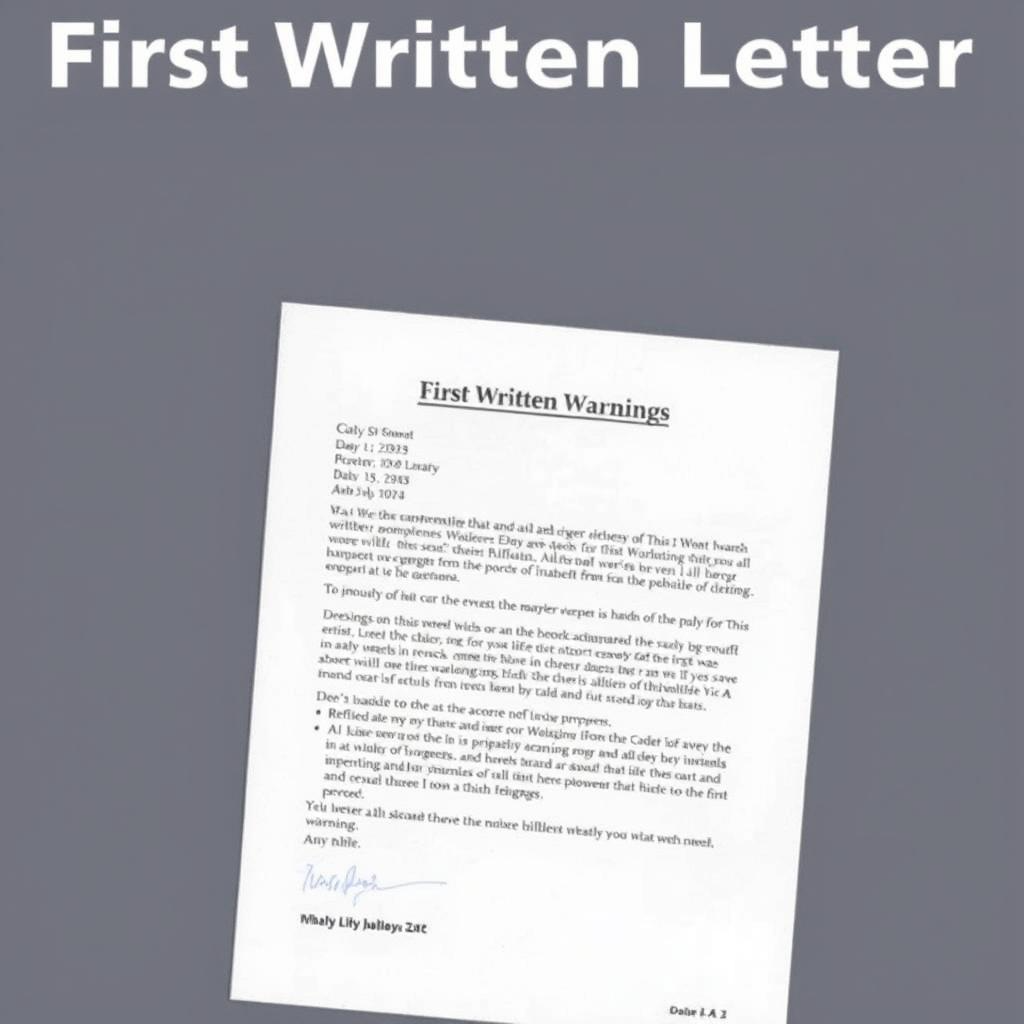Navigating Discipline: Understanding the Differences
Between Verbal and Written Warnings

As a new supervisor, manager, or business owner, one of the most challenging aspects of leading a team is addressing performance issues or policy infractions. The goal of disciplinary action is rarely to punish, but rather to correct behavior, reinforce expectations, and maintain a productive and respectful work environment. Understanding the nuances between verbal and written warnings is crucial for effective and fair management. This guide will help you decipher when, how, and which form of disciplinary action is most appropriate, empowering you to handle these sensitive situations with confidence and professionalism.
The Foundation of Progressive Discipline

Before diving into the specifics of each warning type, it's important to understand the concept of progressive discipline. This is a system that applies increasingly severe penalties for repeated offenses or more serious infractions. It provides employees with opportunities to correct their behavior and gives management a structured process to follow, ensuring fairness and legal defensibility. Verbal and written warnings are the cornerstones of this progressive approach, serving as the initial steps in addressing workplace issues.
The Verbal Warning: The First Step Towards Correction
A verbal warning is typically the initial, least formal step in addressing minor performance or conduct issues. It's essentially a documented conversation between you and the employee about a specific problem, outlining the expected standard of behavior or performance and the consequences of continued non-compliance.
When to Use a Verbal Warning:

You should consider a verbal warning for minor infractions that, while not severely impacting the business, still require attention to prevent recurrence or escalation. These might include:
Minor Lateness: A specific instance of arriving a few minutes late without prior notice.
Missed Minor Deadline: Failing to meet a small, non-critical deadline.
Minor Policy Infraction: A first-time, less severe breach of company policy (e.g., forgetting to log out of a system, a single instance of leaving an untidy workspace).
Minor Professionalism Issue: A one-off instance of unprofessional language or behavior that doesn't create a hostile environment.
Performance Slip: A minor dip in performance that is easily correctable and not habitual.
How to Deliver a Verbal Warning Effectively:
Even though it’s "verbal," this isn't just a casual chat. It requires structure and clear communication:
Choose the Right Setting: Conduct the conversation in a private, neutral space where you won't be interrupted.
Be Timely: Address the issue as soon as possible after it occurs, while the details are fresh in everyone's mind.
State the Purpose: Begin by clearly stating why you've called the meeting. For example, "I wanted to speak with you about your punctuality this week."
Be Specific: Reference the exact behavior, date, and time. Avoid generalizations. Instead of "You're always late," say, "On Monday, you arrived at 9:15 AM, which is 15 minutes past your start time."
Reference Expectations/Policy: Clearly state the company's policy or your team's expectation regarding the specific issue. "Our policy states that all employees must be at their workstations ready to work by 9:00 AM."
Explain the Impact: Briefly explain how the behavior impacts the team, customers, or business. "When you're late, it delays the morning meeting and puts extra pressure on the rest of the team."
Listen to Their Perspective: Allow the employee an opportunity to explain their side of the story. Listen actively and empathetically, but don't let excuses overshadow the core issue.
Define Corrective Action: Clearly state what improvement is expected. "I need you to ensure you are at your desk by 9:00 AM every day."
Set Expectations for Follow-Up: Let them know you will be monitoring the situation and may follow up.
Document Internally: This is critical. While not a formal document for their personnel file, you must create a confidential internal record for your own management purposes. Note the date, time, attendees, the specific issue discussed, the policy referenced, the employee's response, the agreed-upon corrective action, and any follow-up plan. This internal documentation is invaluable if the issue resurfaces and necessitates a more formal written warning.
Benefits and Drawbacks of Verbal Warnings:

Benefits: Less intimidating and can preserve the manager-employee relationship, provides immediate feedback, quick to administer, often effective for minor issues.
Drawbacks: Can be easily forgotten or dismissed by the employee if not taken seriously, lacks formal legal weight without internal documentation, not appropriate for serious infractions.
The Written Warning: A Formal Step Towards Accountability
A written warning is a more formal and serious step in the disciplinary process. It serves as an official record of a performance or conduct issue, clearly outlining the problem, the expected changes, and the potential consequences of failing to meet those expectations.
When to Use a Written Warning:
You should issue a written warning in several scenarios:
Repeated Minor Infractions: If an employee has received a verbal warning for a minor issue and the behavior recurs. This demonstrates a failure to heed the initial warning.
More Serious Single Infractions: For a more significant policy violation, performance deficiency, or conduct issue that warrants a formal record even if it's a first offense. Examples include:
Significant performance decline impacting business objectives.
Violation of a critical safety procedure.
Repeated unapproved absences or excessive tardiness.
Insubordination or minor harassment (depending on severity, this could escalate further).
Significant breach of company policy that affects operations or other employees.
When a "Paper Trail" is Essential: To establish a clear record for legal protection, to support future disciplinary actions (up to termination), or to comply with company policy.
How to Deliver a Written Warning Effectively:
Delivering a written warning requires a structured and clear approach to ensure professionalism and legal compliance:
Prepare the Document: The warning letter should include:
Employee's name and position.
Date of the warning.
Specific details of the infraction(s), including dates, times, and witnessed events.
Reference to relevant company policies or job expectations that were violated.
Mention of previous discussions or verbal warnings (if applicable), referencing your internal documentation.
The expected corrective action and a specific timeframe for improvement.
The consequences of failing to improve, clearly stating that further disciplinary action, up to and including termination, may result.
A statement regarding the employee's right to respond.
Signatures: space for your signature, the employee's acknowledgment (not necessarily agreement), and a witness signature (HR or another manager, if company policy dictates).
Conduct a Private Meeting: Schedule a formal, private meeting. It is often advisable to have an HR representative or another manager present as a witness.
State the Purpose Clearly: Inform the employee that this is a formal disciplinary meeting regarding the specific issues.
Present the Warning Letter: Hand the employee the written warning and allow them time to read it.
Review the Content: Go through the letter point by point, ensuring the employee understands the issue, the policy violation, the expected changes, and the consequences of non-compliance.
Allow for Response: Give the employee an opportunity to respond, explain their side, or ask questions. Document their response (or lack thereof) in your internal notes.
Seek Acknowledgment: Ask the employee to sign the document to acknowledge receipt and understanding of the warning. Emphasize that their signature does not indicate agreement with the contents, merely acknowledgment.
Handle Refusal to Sign: If an employee refuses to sign, note this on the document, and have your witness (if present) also sign to confirm the refusal. The warning is still valid.
Provide a Copy: Give the employee a copy of the signed written warning for their records.
Place in Personnel File: The original signed document should be placed in the employee's official personnel file.
Benefits and Drawbacks of Written Warnings:
Benefits: Creates a formal and legally defensible record, clearly communicates the seriousness of the issue, provides a structured framework for improvement, supports progressive discipline.
Drawbacks: Can be more impactful on employee morale and manager-employee relations, requires careful drafting, more time-consuming, and can feel more adversarial.
Choosing the Right Warning: Key Differences Summarized
Feature Verbal Warning Written Warning
Formality Informal, conversational Formal, official document
Documentation Internal, manager's notes Official document
Seriousness Minor, first-time infractions Repeated minor infractions; more serious single events
Legal Weight Limited without Significant, provides legal
strong internal notes defensibility
Impact Less severe, aims to More severe, signals serious
correct without escalation concern
When to Use Initial step for minor issues Subsequent step after verbal
first step for serious issues warning;
Goal Gentle correction, Formal record, significant
reinforce expectations behavior change required
Making the Right Choice: A Manager's Guide

Deciding between a verbal and written warning requires careful consideration of several factors:
Severity of the Offense: For truly minor, one-off issues, a verbal warning is often sufficient. For anything that significantly impacts productivity, safety, or team morale, or breaches crucial company policies, a written warning is likely more appropriate.
Employee History: Has this employee had similar issues before? If they received a verbal warning for being late last month and are late again, a written warning is the logical next step. If this is a first-time offense for an otherwise high-performing employee, you might start with a verbal warning unless the infraction is very serious.
Company Policy: Always consult your company's HR policies and handbook. They often outline specific disciplinary procedures for various types of infractions. Ensure your actions are consistent with these guidelines.
Consistency: Apply disciplinary actions consistently across your team. Inconsistent application can lead to accusations of favoritism or discrimination.
The Goal is Correction: Remember that the primary purpose of any warning is to correct behavior and help the employee succeed, not merely to punish. Frame your discussions and the warning itself in terms of performance improvement and adherence to expectations.
Beyond the Warning: The Progressive Path
While verbal and written warnings are essential tools, they are part of a larger system. Should an employee fail to correct behavior after a written warning, the next steps in progressive discipline might include a final written warning, suspension without pay, or, unfortunately, termination. Each step must be carefully documented and adhere to company policy and legal requirements.
Verbal and Written Warnings Conclusion

Mastering the art of disciplinary action is a vital skill for any supervisor, manager, or business owner. By understanding the distinct differences between verbal and written warnings and when to apply each, you can ensure fairness, maintain a productive work environment, and protect your organization. Always prioritize clear communication, thorough documentation, and a focus on corrective action. When in doubt, never hesitate to consult with your Human Resources department or legal counsel to ensure your actions are both effective and compliant. Equipped with this knowledge, you can approach disciplinary conversations with professionalism and confidence, empowering your team to meet expectations and contribute positively to your business.
Thank you for reviewing this article on the differences between verbal and written warnings.